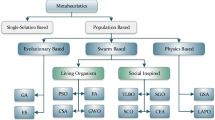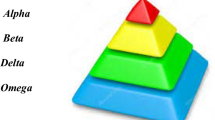Abstract
Nowadays, the design of optimization algorithms is very popular to solve problems in various scientific fields. The optimization algorithms usually inspired by the natural behaviour of an agent, which can be humans, animals, plants, or a physical or chemical agent. Most of the algorithms proposed in the last decade inspired by animal behaviour. In this article, we present a new optimizer algorithm called the wild horse optimizer (WHO), which is inspired by the social life behaviour of wild horses. Horses usually live in groups that include a stallion and several mares and foals. Horses exhibit many behaviours, such as grazing, chasing, dominating, leading, and mating. A fascinating behaviour that distinguishes horses from other animals is the decency of horses. Horse decency behaviour is such that the foals of the horse leave the group before reaching puberty and join other groups. This departure is to prevent the father from mating with the daughter or siblings. The main inspiration for the proposed algorithm is the decency behaviour of the horse. The proposed algorithm was tested on several sets of test functions such as CEC2017 and CEC2019 and compared with popular and new optimization methods. The results showed that the proposed algorithm presented very competitive results compared to other algorithms. The source code is currently available for public from: https://www.mathworks.com/matlabcentral/fileexchange/90787-wild-horse-optimizer.











Similar content being viewed by others
References
Chong EKP, Żak SH (2008) An introduction to optimization. Wiley, Hoboken
Dréo J (2006) Metaheuristics for hard optimization. Springer-Verlag, Berlin/Heidelberg
Mafarja M, Aljarah I, Heidari AA et al (2018) Evolutionary population dynamics and grasshopper optimization approaches for feature selection problems. Knowl-Based Syst 145:25–45. https://doi.org/10.1016/j.knosys.2017.12.037
Aljarah I, Mafarja M, Heidari AA et al (2018) Asynchronous accelerating multi-leader salp chains for feature selection. Appl Soft Comput 71:964–979. https://doi.org/10.1016/j.asoc.2018.07.040
Holland JH (1967) Genetic algorithms understand genetic algorithms. Surprise 96(1):12–15. https://doi.org/10.2307/24939139
Eberhart R, Kennedy J (2002) A new optimizer using particle swarm theory. In: MHS’95. In: Proceedings of the Sixth International Symposium on Micro Machine and Human Science. IEEE, pp 39–43
Yang X-S (2010) Firefly algorithm, Lévy flights and global optimization. Research and development in intelligent systems XXVI. Springer, London, pp 209–218
Mirjalili S, Mirjalili SM, Lewis A (2014) Grey wolf optimizer. Adv Eng Softw 69:46–61. https://doi.org/10.1016/j.advengsoft.2013.12.007
Rashedi E, Nezamabadi-pour H, Saryazdi S (2009) GSA: a gravitational search algorithm. Inf Sci (NY) 179:2232–2248. https://doi.org/10.1016/j.ins.2009.03.004
Mirjalili S (2015) The ant lion optimizer. Adv Eng Softw 83:80–98. https://doi.org/10.1016/j.advengsoft.2015.01.010
Mirjalili S, Lewis A (2016) The whale optimization algorithm. Adv Eng Softw 95:51–67. https://doi.org/10.1016/j.advengsoft.2016.01.008
Mirjalili S, Mirjalili SM, Hatamlou A (2016) Multi-verse optimizer: a nature-inspired algorithm for global optimization. Neural Comput Appl 27:495–513. https://doi.org/10.1007/s00521-015-1870-7
Mirjalili S, Gandomi AH, Mirjalili SZ et al (2017) Salp Swarm algorithm: a bio-inspired optimizer for engineering design problems. Adv Eng Softw 114:163–191. https://doi.org/10.1016/j.advengsoft.2017.07.002
Samareh Moosavi SH, Bardsiri VK (2019) Poor and rich optimization algorithm: a new human-based and multi populations algorithm. Eng Appl Artif Intell 86:165–181. https://doi.org/10.1016/j.engappai.2019.08.025
Heidari AA, Mirjalili S, Faris H et al (2019) Harris hawks optimization: algorithm and applications. Future Gener Comput Syst 97:849–872. https://doi.org/10.1016/j.future.2019.02.028
Abdullah JM, Ahmed T (2019) Fitness dependent optimizer: inspired by the bee swarming reproductive process. IEEE Access 7:43473–43486. https://doi.org/10.1109/ACCESS.2019.2907012
Anita YA, Kumar N (2020) Artificial electric field algorithm for engineering optimization problems. Expert Syst Appl 149:113308. https://doi.org/10.1016/j.eswa.2020.113308
Houssein EH, Saad MR, Hashim FA et al (2020) Lévy flight distribution: a new metaheuristic algorithm for solving engineering optimization problems. Eng Appl Artif Intell 94:103731. https://doi.org/10.1016/j.engappai.2020.103731
Kaur S, Awasthi LK, Sangal AL, Dhiman G (2020) Tunicate Swarm Algorithm: a new bio-inspired based metaheuristic paradigm for global optimization. Eng Appl Artif Intell 90:103541. https://doi.org/10.1016/j.engappai.2020.103541
Awad NH, MZ. Ali JJ, Liang BY, Qu PS (2016) Problem definitions and evaluation criteria for the CEC 2017 special session and competition on single objective real-parameter numerical optimization. Tech Rep
Mirjalili S (2015) Moth-flame optimization algorithm: a novel nature-inspired heuristic paradigm. Knowl-Based Syst 89:228–249. https://doi.org/10.1016/j.knosys.2015.07.006
Wolpert DH, Macready WG (1997) No free lunch theorems for optimization. IEEE Trans Evol Comput 1:67–82. https://doi.org/10.1109/4235.585893
Carson K, Wood-Gush DGM (1983) Equine behaviour: I. A review of the literature on social and dam—Foal behaviour. Appl Anim Ethol 10:165–178. https://doi.org/10.1016/0304-3762(83)90138-4
Carson K, Wood-Gush DGM (1983) Equine behaviour: II. A review of the literature on feeding, eliminative and resting behaviour. Appl Anim Ethol 10:179–190. https://doi.org/10.1016/0304-3762(83)90139-6
Feist JD, McCullough DR (1975) Reproduction in feral horses. J Reprod Fertil Suppl (23):13–18. PMID:1060766
Klingel H (1975) Social organization and reproduction in equids. J Reprod Fertil Suppl 7–11
Wells SM, Goldschmidt-Rothschild B (2010) Social behaviour and relationships in a herd of camargue horses. Z Tierpsychol 49:363–380. https://doi.org/10.1111/j.1439-0310.1979.tb00299.x
Miller R, Dennisto RH (2010) Interband dominance in feral horses. Z Tierpsychol 51:41–47. https://doi.org/10.1111/j.1439-0310.1979.tb00670.x
Squires VR, Daws GT (1975) Leadership and dominance relationships in Merino and Border Leicester sheep. Appl Anim Ethol 1:263–274. https://doi.org/10.1016/0304-3762(75)90019-X
Welsh DA, University D (1975) Population, behavioural and grazing ecology of the horses of Sable Island, Nova Scotia. PhD thesis, Dalhousie University
Saremi S, Mirjalili S, Lewis A (2017) Grasshopper optimisation algorithm: theory and application. Adv Eng Softw 105:30–47. https://doi.org/10.1016/j.advengsoft.2017.01.004
Mirjalili S (2016) SCA: a sine cosine algorithm for solving optimization problems. Knowl-Based Syst 96:120–133. https://doi.org/10.1016/j.knosys.2015.12.022
Awad NH, Ali MZ, Suganthan PN, Liang JJ, Qu BY (2017) Problem definitions and evaluation criteria for the CEC 2017 special session and competition on single objective real-parameter numerical optimization. In: 2017 IEEE Congress on Evolutionary Computation (CEC)
Price KV, Awad NH, Ali MZ, PNS (2018) The 100-digit challenge: problem definitions and evaluation criteria for the 100-digit challenge special session and competition on single objective numerical optimization. Sch Elect Electron Eng, Nanyang Technol Univ, Singapore, Tech Rep
Kumar A, Wu G, Ali MZ et al (2020) A test-suite of non-convex constrained optimization problems from the real-world and some baseline results. Swarm Evol Comput 56:100693. https://doi.org/10.1016/j.swevo.2020.100693
Floudas CA, Ciric AR, Grossmann IE (1986) Automatic synthesis of optimum heat exchanger network configurations. AIChE J 32:276–290. https://doi.org/10.1002/aic.690320215
Kocis GR, Grossmann IE (1988) Global optimization of nonconvex mixed-integer nonlinear programming (MINLP) problems in process synthesis. Ind Eng Chem Res 27:1407–1421. https://doi.org/10.1021/ie00080a013
Kocis GR, Grossmann IE (1989) A modelling and decomposition strategy for the minlp optimization of process flowsheets. Comput Chem Eng 13:797–819. https://doi.org/10.1016/0098-1354(89)85053-7
Belegundu AD, Arora JS (1985) A study of mathematical programming methods for structural optimization. Part I: theory. Int J Numer Methods Eng 21:1583–1599. https://doi.org/10.1002/nme.1620210904
Nowacki H (1973) Optimization in pre-contract ship design. In: International Conference on Computer Applications in the Automation of Shipyard Operation and ShipDesign, pp 1–12
Rao SS (1996) Engineering optimization: theory and practice. New Age International Publishers
Gupta S, Tiwari R, Nair SB (2007) Multi-objective design optimisation of rolling bearings using genetic algorithms. Mech Mach Theory 42:1418–1443. https://doi.org/10.1016/j.mechmachtheory.2006.10.002
Beightler CSPD (1976) Applied geometric programming. Wiley
Mautner DH (1972) Applied nonlinear programming. McGraw-Hill Co
Author information
Authors and Affiliations
Corresponding author
Rights and permissions
About this article
Cite this article
Naruei, I., Keynia, F. Wild horse optimizer: a new meta-heuristic algorithm for solving engineering optimization problems. Engineering with Computers 38 (Suppl 4), 3025–3056 (2022). https://doi.org/10.1007/s00366-021-01438-z
Received:
Accepted:
Published:
Issue Date:
DOI: https://doi.org/10.1007/s00366-021-01438-z




